WHAT'S NEW ACROSS THE WORLD
| What's New ©by
Laif DeMason
A new year is finally here! It seemed like 2005
would never end. Mother Nature has dealt many severe blows across the world.
Here in Miami, Florida, we had to endure the destruction of two hurricanes
in one year. The young Hurricane Katrina flooded many of the South Florida
cichlid farms before she matured and dealt massive destruction to Louisiana
and Mississippi. Hurricane Wilma then came and destroyed power grids in
over five counties of southern Florida, leaving most to make due with no
electricity for two weeks. Hurricanes, floods, wildfires, and earthquakes
also cause major disruptions in other areas of the world.
With the onset of Winter, are your aquarium back-up
systems in place? Storms can knock out power and leave your tanks, and
fish, with no electricity. Be prepared to operate for at least 72 hours
on your own back-up systems when catastrophe occurs!
Here’s “what’s new” on the cichlid scene: |
Lake Tanganyika
Interest and, fortunately, supplies are strong this season. Collections
and exports are occurring at all points on the Lake. In the United States,
shell-dwellers, altolamprologines, and other substrate-spawners remain
popular. In other areas of the world, Tropheus and sand cichlids are more
popular. I guess there is something for everyone!
|
what's new: Lake Tanganyika
|

Caught in the northern extreme of Ubwari, Congo, Tropheus
sp. Muzimu looks somewhat like the form from Mboko, nearby. Photo by M.
Lillie. |

Of all the popular blue Cyphotilapia frontosa forms,
the variety from Moba, Congo seems to exhibit the strongest deep blue coloration. |

Collected from Ikola, Tanzania, Callochromis
sp. Ikola red line has not been exported for some years. Photo by A. Konings. |

Displaying characteristically strong coloration, Xenotilapia
ochrogenys Ndole Bay is a favorite of many enthusiasts. Photo by A.
Konings. |
Lake Malawi
Collections and exports remain strong from most points along Lake Malawi.
Active searches for new items have brought forth the usual mix of new species
and not-so-new varieties. Many “new” Aulonocara are actually caught
between the more routine collection areas and, thus, look somewhat like
better-known forms; time will tell if any are different enough to remain
of interest to hobbyists. Bred items are also available in good numbers
and in a wide range of species and varieties.

Seasonally available during December and January,
Buccochromis spectabilis is now also available from bred sources. |

Small mbuna from Lake Malawi remain popular with hobbyists;
pictured here, Labidochromis freibergi is well known to many “old
timers.” |

Now available on a regular basis, Cynotilapia afra
yellow Mara has gained in popularity. |

Newly-discovered on a reef off Likoma Island, Malawi,
Pseudotropheus cf. heteropictus with black trim is an infrequent
export. Photo by A. Konings. |
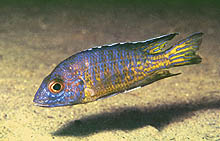
Collected near Charo, Malawi, Aulonocara Mkondiwe
sports coloration similar to the “flavescent Usisya” with stronger blue
hues. Photo by A. Konings. |
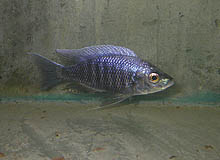
Newly-collected from Chitimba, Malawi, Copadichromis
virginalis has a pleasant sky-blue body color. |
West Africa
Exports from the usual countries in West Africa continue per normal.
While few actual new species are reported, many of the recent exports are
still unknown to most cichlid hobbyists. Some of these West African species
are being bred in larger numbers by different specialists, thus increasing
the awareness of the most popular forms.

From Nigeria, Pelvicachromis pucher Isokpo
is a colorful and recently- imported form of the ever-popular “krib.” Photo
by A. Bornstein. |

Seasonally collected downriver from Kinshasa, Congo,
Pelvicachromis subocellatus Moanda is also occasionally bred by
specialists. Photo by O. Lucanus. |
Neotropics
Several exporting countries in South America are currently undergoing
their low season for collecting. However, bred cichlids from many neotropical
specialists are available. Some species not seen for a while are often
“recycled,” and some newer varieties are produced in larger numbers. There
always seems to be plenty to choose from with cichlids from the Americas!

Occasionally imported from Iquitos, Peru, Apistogramma
eremnopyge is also bred by a few suppliers. Photo by O. Lucanus. |
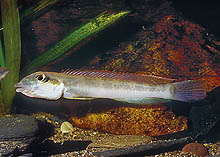
Exported somewhat regularly now and collected from
the Tapajos River area of Brazil, Teleocichla cinderella. Photo
by O. Lucanus. |
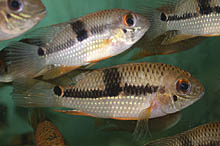
Imported from Peru as Aequidens sp. “Rojo”,
A. diadema makes a nice addition to the Neotropical community tank.
Photo by A. Bornstein. |
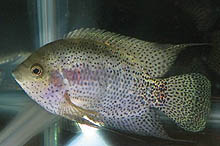
One of the big winners in the recent American Cichlid
Association show, Archocentrus spinossisimus. Photo by K. Friesen. |
|















